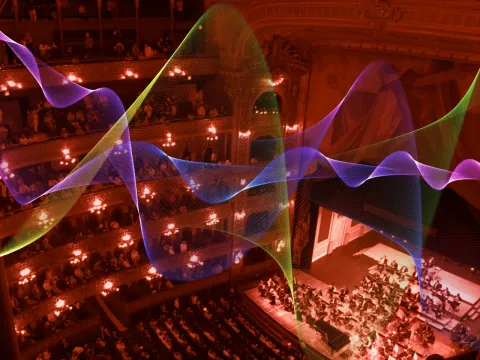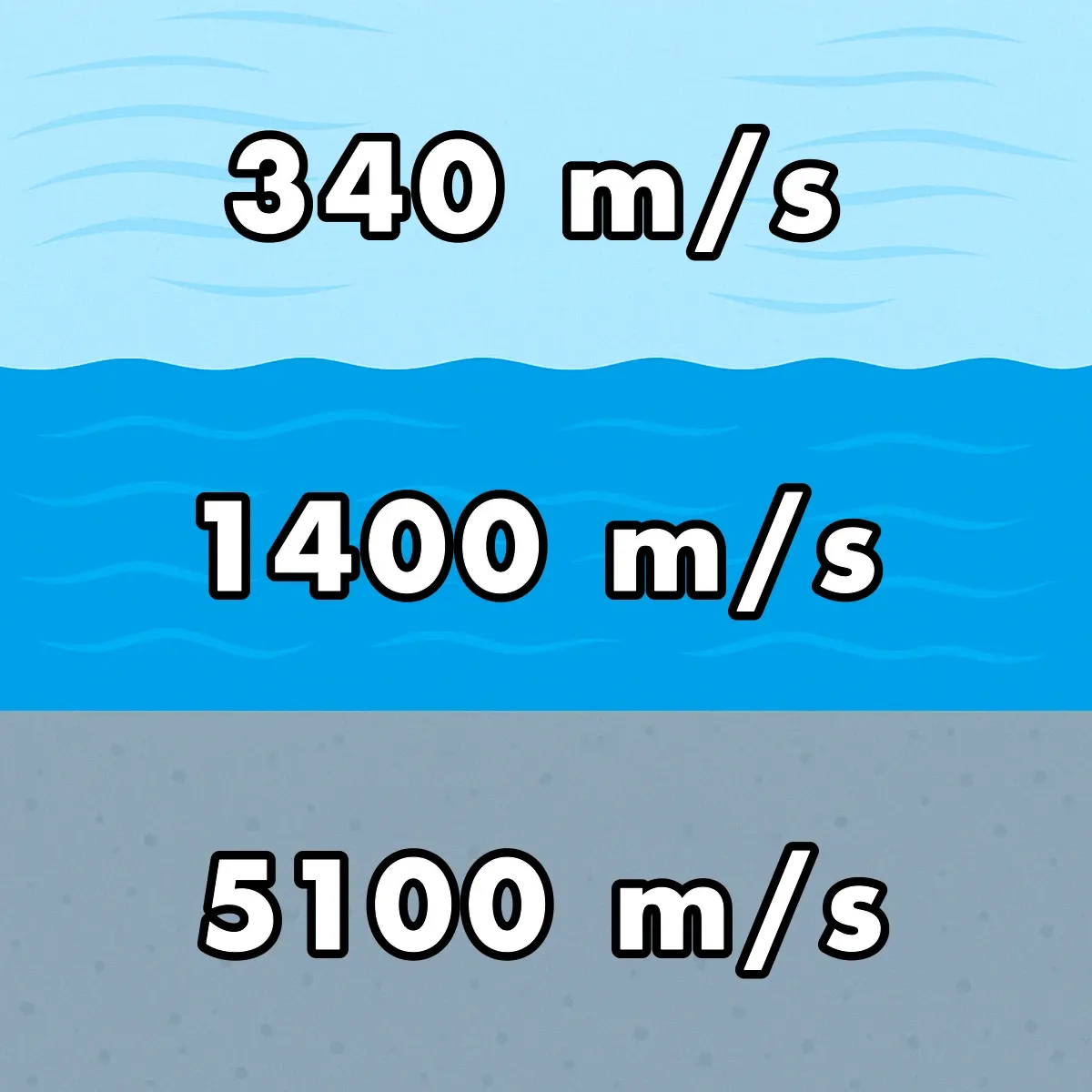Speed of Sound: How It Changes and How We Hear It
The speed of sound is not always the same. It changes depending on the material, temperature, and the conditions where sound travels. In this article, we will explain how the speed of sound changes in air, water, and other materials, why space is silent, and how people hear sound in different places.
What Is Sound

Vibration of a guitar string and the emergence of a sound wave
Sound is a physical phenomenon. It is made up of acoustic waves—these are waves that move through air or another material when something vibrates. A vibrating object, like a guitar string, makes the air molecules near it move back and forth. These moving molecules push on the next ones, and this continues in a chain. This creates a sound wave. Our ears catch these waves and their physical properties. Our brain then processes these signals and lets us hear the sound in our own way. So, when we talk about the speed of sound, we need to think about both its physical nature and how people hear it. Learn more about what a sound wave is and how people hear sound.
What Is the Speed of Sound and How Is It Measured?
So, sound is made of acoustic waves created by vibrations that move between particles in whatever material they travel through. The speed of sound means how fast these sound waves travel through a material. In a vacuum (empty space), there is nothing—no molecules—so vibrations cannot move. That means there is no sound in a vacuum, and no speed of sound there. The speed of sound is usually measured in meters per second, but sometimes it can be measured in kilometers per hour.
In air at about 20°C (room temperature), sound travels at about 340 meters per second. In water, it travels at about 1500 meters per second.
What Changes the Speed of Sound?
What affects the speed of sound? Since the speed depends on where it travels, the main things that matter are how dense and how elastic the material is. For example, sound moves faster in water than in air, and even faster in metals than in water.
The speed of sound in air can also change a little depending on what gases are mixed in the air and how much of each gas there is.
For example, according to Dr. Carl Nave (HyperPhysics), at 35°C, sound travels 50 meters per second faster in water vapor than in regular air, and in helium it is about three times faster (about 1000 meters per second) than in air. When someone breathes in helium, their voice sounds higher and funny. This happens because helium makes sound travel much faster through your mouth and throat.

The speed of sound is 340 m/s. It depends on the temperature, pressure, and composition of the air
Temperature also changes how fast sound moves through air or other materials. The warmer it is, the faster sound travels. For example, at 20°C (room temperature), sound travels at about 343 meters per second. At 0°C (freezing), it goes at 331 meters per second. At 35°C (hot), it goes at 352 meters per second.
Air pressure also has a small effect on the speed of sound in air.
The speed of sound depends on how dense, elastic, warm, and what kind of material it travels through, as well as the pressure. That’s why it changes a lot between gases, liquids, and solids.
Speed of Sound in Different Materials
As mentioned before, the speed of sound depends on how close together the particles are in a material. In liquids and solids, particles (molecules or atoms) are closer together than in gases, so vibrations move faster. In gases, particles are farther apart, so sound moves slower. In a vacuum (empty space), there are no particles at all, so sound cannot travel there.
The table below shows how fast sound travels through different materials.
Table 1. Speed of Sound in Different Materials
| Material | Temperature | Speed of Sound (m/s) |
|---|---|---|
| Vacuum | - | 0 m/s |
| Air | 20°C | 343 m/s |
| Water vapor | 35°C | 402 m/s |
| Helium | 20°C | 927 m/s |
| Water | 10°C | 1446 m/s |
| Castor oil | 25°C | 1490 m/s |
| Wood | - | 3000–4000 m/s |
| Steel | - | 5100 m/s |
How People Hear the Speed of Sound
People often feel like they hear sounds instantly as soon as they happen, but this isn’t true. Sound actually takes time to reach your ears. For example, if something makes a noise 100 meters away from you, you will hear it about 0.3 seconds later.
EXAMPLE: During a thunderstorm, we usually see lightning first and then hear thunder after a few seconds. This happens because light travels much faster than sound. If you hear thunder 6 seconds after seeing lightning, the lightning struck about two kilometers away from you.
In everyday life, small changes in the speed of sound do not really affect what we hear. They only change how quickly the sound reaches us.
Delays in how fast sound reaches us affect what we hear and how we understand sounds. Our brain notices these delays between our two ears and can tell the difference between echoes (sound bouncing back) and direct sounds (going straight to us). This helps us know where a sound is coming from and makes sounds feel three-dimensional or “surrounding.”
Reverberation and the Feeling of Space in Sound

Reverberation in a concert hall - voluminous and deep sound, a sense of grandeur
Sound spreads out from its source in all directions like a sphere. When it hits things like walls or floors, it bounces back. Sound can also go around obstacles. The effect of sound bouncing many times off different surfaces is called reverberation.
Reverberation gives us a sense of space—how big or small a room feels—and helps us know where a sound comes from. However, echoes caused by reverberation can sometimes make it harder to hear direct (not reflected) sounds clearly.
Conclusion
Although sound travels quickly, we perceive it as a process rather than a moment. Our perception of the speed of sound or delays in sound transmission is the result of complex coordination between the auditory system and the brain. This is why room acoustics and delays in audio systems are so important for sound quality and listening comfort.
Information sources
- HyperPhysics, Measuring the speed of sound in air and other gases
- engineeringtoolbox, calculations of sound speed
- The book "Sound: Listening, Hearing, Observing" by Michel Chion
- The book "On Music. The Science of Human Obsession with Sound", by Daniel Levitin
- College of Earth and Mineral Sciences: Molecular Dynamics of Air
Author team instrumental-music.eu
Last updated:

The speed of sound in gases, liquids, and solids: what it depends on and how people sense it